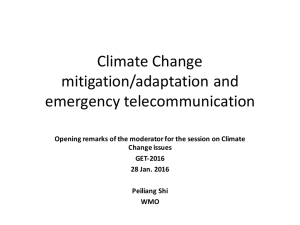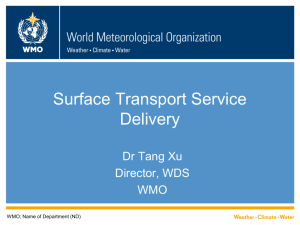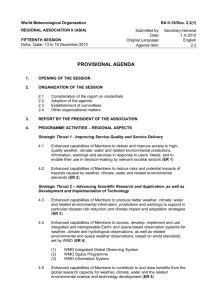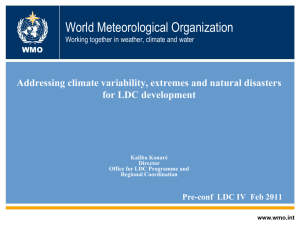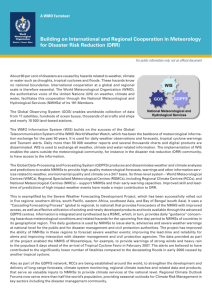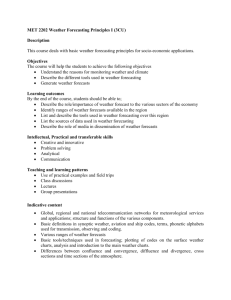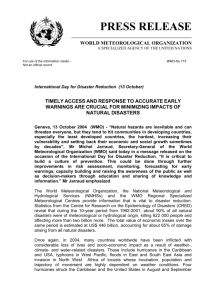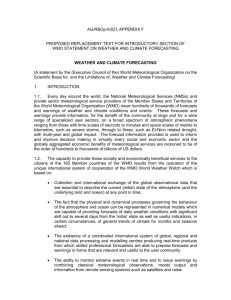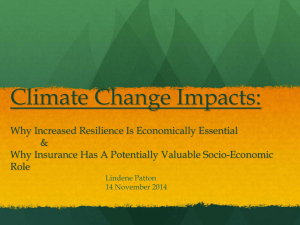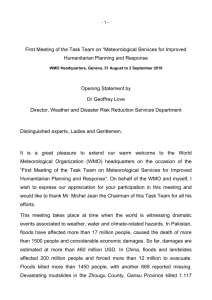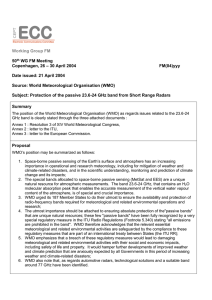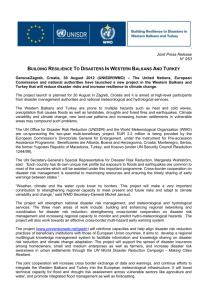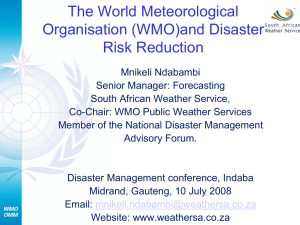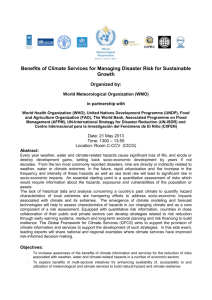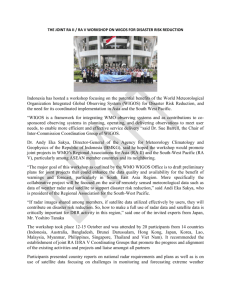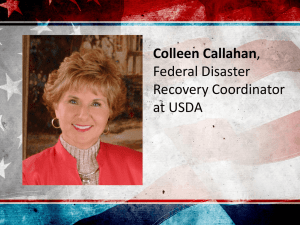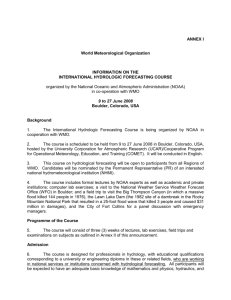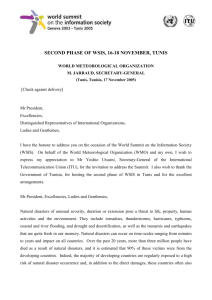English
advertisement
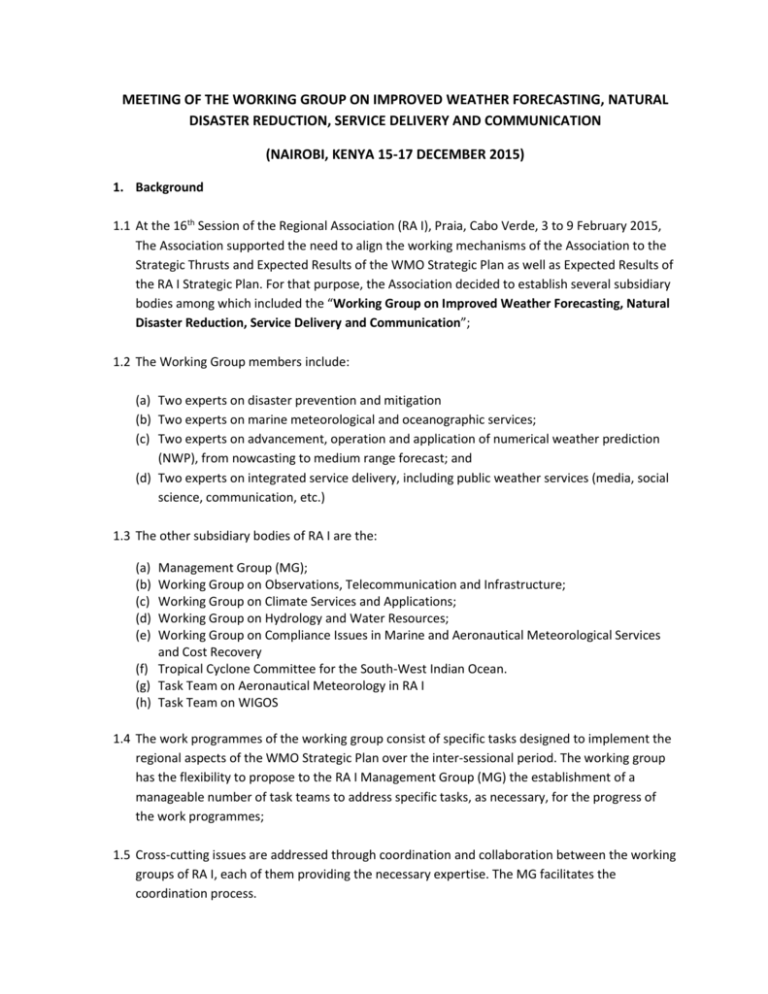
MEETING OF THE WORKING GROUP ON IMPROVED WEATHER FORECASTING, NATURAL DISASTER REDUCTION, SERVICE DELIVERY AND COMMUNICATION (NAIROBI, KENYA 15-17 DECEMBER 2015) 1. Background 1.1 At the 16th Session of the Regional Association (RA I), Praia, Cabo Verde, 3 to 9 February 2015, The Association supported the need to align the working mechanisms of the Association to the Strategic Thrusts and Expected Results of the WMO Strategic Plan as well as Expected Results of the RA I Strategic Plan. For that purpose, the Association decided to establish several subsidiary bodies among which included the “Working Group on Improved Weather Forecasting, Natural Disaster Reduction, Service Delivery and Communication”; 1.2 The Working Group members include: (a) Two experts on disaster prevention and mitigation (b) Two experts on marine meteorological and oceanographic services; (c) Two experts on advancement, operation and application of numerical weather prediction (NWP), from nowcasting to medium range forecast; and (d) Two experts on integrated service delivery, including public weather services (media, social science, communication, etc.) 1.3 The other subsidiary bodies of RA I are the: (a) (b) (c) (d) (e) Management Group (MG); Working Group on Observations, Telecommunication and Infrastructure; Working Group on Climate Services and Applications; Working Group on Hydrology and Water Resources; Working Group on Compliance Issues in Marine and Aeronautical Meteorological Services and Cost Recovery (f) Tropical Cyclone Committee for the South-West Indian Ocean. (g) Task Team on Aeronautical Meteorology in RA I (h) Task Team on WIGOS 1.4 The work programmes of the working group consist of specific tasks designed to implement the regional aspects of the WMO Strategic Plan over the inter-sessional period. The working group has the flexibility to propose to the RA I Management Group (MG) the establishment of a manageable number of task teams to address specific tasks, as necessary, for the progress of the work programmes; 1.5 Cross-cutting issues are addressed through coordination and collaboration between the working groups of RA I, each of them providing the necessary expertise. The MG facilitates the coordination process. 2. Objectives of the meeting 2.1 To develop terms of Reference (ToRs) of the Working Group on Improved Weather Forecasting, Natural Disaster Reduction, Service Delivery and Communication for consideration by the Management Group; 2.2 To examine the WMO Strategic Plan and agree on the specific tasks that would enable implementation of the regional aspects of the Plan that fall within the areas of responsibility of the Working Group, namely: weather forecasting, disaster reduction and service delivery; 2.3 To examine decisions of the RA I Session (Praia, Cabo Verde, 3 to 9 February 2015), as well decisions of 17th Session of the World Meteorological Congress (Cg-17) relevant to the WG and recommend best ways to implement them; 2.4 To suggest mechanisms (e.g. tasks teams) that would steer the implementation of specific tasks for consideration by the MG of RA I; 2.5 To agree on a Work Plan for the Working Group for the implementation during the InterSessional Period. 3. Stakeholders The meeting will involve the members of the Working Group, the WMO secretariat, National Meteorological Services (NMHSs) and the RA I Management Group. 4. Format 4.1 The sessions will include keynote presentations by members of the Working group in their areas of competence with the purpose of bringing to focus, points that would need discussion within the three major areas of the WG; 4.2 Issues linked to the implementation of key projects and initiatives in the Region will be considered. These would include: the WMO Strategy for Service Delivery; impact-based forecasting and warning; implementation of the Common Alerting Protocol (CAP) standard in the communication of warnings; issues related to the implementation of the Severe Weather Forecasting Demonstration (SWFDP); Response to the UN World Conference on Disaster Risk Reduction (WCDRR) i.e. The Sendai Conference (Sendai, Japan, March 2015) and implications to NMHSs; Multi-Hazard Early Warning Systems (MHEWS); Cataloguing of hazards etc.; 4.3 Time slots for presentations will be 30-40 minutes allowing for a question and answer session after each presentation. 4.4 There will be breakout groups to discuss certain issues as necessary 4.5 A session will be held at the end of the meeting to summarize the discussions and formulate recommendations to the Management Group and RA I Members.
